Bodinayakkanur
Historical background
Bodinayakkanur, picturesquely sited at the foot hills of Western Ghats in the Theni district, of Tamil Nadu, is a thriving market town where cardamom, coffee, tea, pepper, and silk-cotton are traded.
The zamindars of Bodinayakkanur Palayapattu, whose history goes back to the 14th century, claim to be the descendants of the mythical Kalaikottu Munivar, i.e. Rishyashringa maharishi. They belong to the Rajakambalam Nayakas, a Telugu speaking group who fled from the Bellary region, in present-day Karnataka State, when, in the early 14th century, the troops of Alauddin Khilji invaded that region. They migrated first to western Tami Nadu, then proceeded southwards and eventually settled in the area of Bodinayakkanur.
Read more
In the heart of the town is the palace of the Zamindar of Bodinayakkanur Palayapattu Zamin, built by Bangaru Tirumalai Bodi Nayaka (r. 1849 – 1862). The sprawling building, unfortunately in a sad state of disrepair, houses a generous-sized Darbar hall, the Lakshmi Vilasam, a large room used in bygone days as treasury, a gymnasium, a visitors’ hall, stables for horses and elephants, and a granary. At the death of Bangaru Tirumalai Bodi Nayaka in 1862, his heir Tirumalai Bodaiya Kamaraja Pandya Nayaka was a minor, so the British first took over the administration of the state and, in due course, its territory.
An extensive set of Ramayana paintings, dating of the mid-19th century, adorns the walls of the Lakshmi Vilasam and the Darbar hall. Above each scene is an explanatory caption in colloquial Tamil. The Balakanda narrative, from the beginning up to the departure of the four princely couples from Mithila is ingeniously laid out on the walls of the Lakshmi Vilasam. Particularly interesting are the scenes dealing with the nuptial rituals and the ceremonies, performed according to the Rajakambalam Nayakas traditions. A small shrine in this room houses a painting of the eight-armed family deity of the ruling family, Vadamalai Nachiammannai.
The rest of the narrative is illustrated in great detail on the walls of the Darbar Hall. The rendering of the Parashurama episode followed by the arrival of the newly wed couples in Ayodhya is, strangely enough, the sole episode painted on a portion of the Darbar Hall’s ceiling. Episodes from the Yuddhakanda, such as Indrajit’s sacrifice in Nikumbhila, as well as scenes of music and dance are found on the underside of the lobed arches supporting the hall’s ceiling. Sadly a section of the murals depicting the Yuddhakanda, is lost.
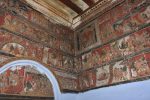
Date: mid-19th century
Description: Top row (on the right of the corner, from left to right): The dikpalas worship Vishnu reclining on the coils of the serpent Shesha, enshrined in a temple on an island; This may refer to Sri Ranganatha temple at Srirangam; Vishnu, Shiva and Brahma on their vahanas; Second row: Namakarana (name giving ceremony); Third row: Vishvamitra and Vasishtha talk to king Dasharatha; Dasharatha is devastated on hearing Vishvamitra’s request; Rama and Lakshmana leave with the sage; Fourth row: Vishvamitra and his charges are ferried across the river and perform their ablutions.
Top row (on the left of the corner, from left to right); Dasharatha gifts cows to the Brahmins; the babies are given a bath; Second row; Rama hits Kuni (Manthara) with mud pellets; the princes and their mothers; the arrival of Vishvamitra; Third row; Rama and Lakshmana protect the sages’ yajna; Subahu is killed; The princes are praised by the rishis; they spend the night under the watchful gaze of Vishvamitra; Fourth row; Rama breaks Shiva’s bow; Sita’s suitors are devastated.
Location: Tamil Nadu Palace;Bodinayakkanur
Positioning: Lakshmi Vilasam
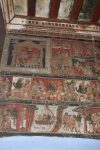
Date: mid-19th century
Description: Top row: The dikpalas worship Vishnu reclining on the coils of the serpent Shesha; Vishnu and Shiva on their vahanas; Second row: Dasharatha and the queens celebrate their children namakarana (name giving ceremony); Third row: Vishvamitra and Vasishtha talk to Dasharatha; Dasharatha is devastated on hearing Vishvamitra’s request; Rama and Lakshmana leave with the sage; Fourth row: Vishvamitra and his charges are ferried across a river. They perform their ablutions.
Location: Tamil Nadu;Palace;Bodinayakkanur
Positioning: Lakshmi Vilasam
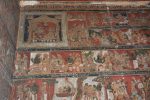
Date: mid-19th century
Description: Top row: The dikpalas worship Vishnu reclining on the coils of the serpent Shesha; Vishnu, Shiva and
Brahma on their vahanas; Second row: Dasharatha and the queens with their children on their lap celebrate the namakarana (name giving ceremony) officiated by Vasishtha; Third row: Vishvamitra and Vasishtha talk to Dasharatha; Dasharatha is devastated on hearing Vishvamitra’s request; Rama and Lakshmana leave with the sage; Fourth row: Vishvamitra and his charges are ferried across a river; They perform their ablutions; Rama frees Ahalya from her curse.
Location: Tamil Nadu Palace;Bodinayakkanur
Positioning: Lakshmi Vilasam
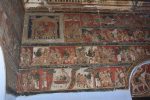
Date: mid-19th century
Description: Top row: The dikpalas worship Vishnu reclining on the serpent Shesha; Vishnu, Shiva and Brahma on their vahanas; The dikpalas pay homage to the three gods seated atop a mountain; Second row: Dasharatha and the queens with the children on their lap, at the namakarana (name giving) ceremony officiated by Vasishtha; Third row: Vishvamitra and Vasishtha talk to Dasharatha; Dasharatha is devastated on hearing Vishvamitra’s request; Rama and Lakshmana leave with the sage; the queens and the courtiers say farewell to them; Fourth row: Vishvamitra and his charges are ferried across a river. They perform their ablutions; Rama frees Ahalya from her curse, immediately behind her is her husband, Gautama.
Location: Tamil Nadu Palace;Bodinayakkanur
Positioning: Lakshmi Vilasam
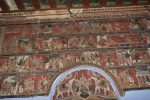
Date: mid-19th century
Description: Top row: Vishnu, Shiva and Brahma on their vahanas; The dikpalas pay homage to the three gods seated atop a mountain; Narada discovers the sage Valmiki buried in an anthill writing on a palm leaf; Shravanakumara carries his blind parents in baskets tied to a yoke; He is accidentally killed by Dasharatha; Second row: The namakarana (name giving) ceremony is performed by Vasishtha; The queens and a nurse, nursing the four babies; They watch the infants crawling; Third row: Dasharatha is devastated by Vishvamitra’s request; He entrusts Rama and Lakshmana to the sage, and along with the queens and courtiers escorts them to the gates of Ayodhya; They arrive in the forest and spend their first night there; They reach an ashram; Fourth row: Vishvamitra and his charges are ferried across a river; They perform their ablutions. Rama frees Ahalya from her curse, immediately behind her is her husband Gautama. In the arch above the door leading to the puja room, Gajalakshmi; On the right: Vishvamitra and the princes arrive in Mithila.
Location: Tamil Nadu Palace;Bodinayakkanur
Positioning: Lakshmi Vilasam
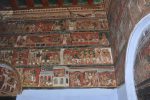
Date: mid-19th century
Description: Top row: The dikpalas pay homage to Vishnu, Shiva and Brahma; Shravanakumara carries his blind parents in baskets tied to a yoke; He is accidentally killed by Dasharatha; The king talks to the youth’s parents; King Romapada talks to two ascetics; The courtesans leave the town; Second row: The queens nurse the babies and watch the crawling toddlers; The princes are being schooled by Vasishtha; Third row: Rama and Lakshmana walk through the forest with Vishvamitra; They spend their first night in the wilderness; They follow their guide and listen to his words; After crossing a river they meet some ascetics and listen to their discourses; Three ascetics
bid farewell to Vishvamitra and the boys; Fourth row: The trio arrives in Mithila, Sita from the window of her palace sees Rama; Vishvamitra talks to a gatekeeper; King Janaka prostrates before the sage; Vishvamitra and the princes talk to the king and his minister.
Location: Tamil Nadu Palace;Bodinayakkanur
Positioning: Lakshmi Vilasam
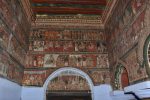
Date: mid-19th century
Description: Top row: The courtesans seduce Rishyashringa, they take him to the Anga country, and the drought ceases; The wedding of Shanta and Rishyashringa (Kalaikottu munivar); Second row: Vasishtha trains the princes in horse and elephant riding; Third row: Vishvamitra and his charges are ferried across a river
they enter a forest where they encounter Tataka; Fourth row: Janaka, his chaplain and his ministers talk to Vishvamitra and his charges; Vishvamitra and the princes before the assembled court; Janaka Vishvamitra, the princes and Janaka’s chaplain look on while the king instructs four servants to fetch Shiva’s bow.
Location: Tamil Nadu Palace;Bodinayakkanur
Positioning: Lakshmi Vilasam
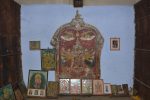
Date: mid-19th century, heavily retouched
Description: Vijayalakshmi (Vadamalai Nachiammannai), tutelary deity of the Bodinayakkanur Palayapattu Zamindars.
Location: Tamil Nadu Palace;Bodinayakkanur
Positioning: Lakshmi Vilasam
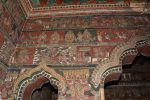
Date: mid-19th century
Description: Top row: Rishyashringa (Kalaikottu munivar) arrives in Ayodhya and is welcomed by Dasharatha, Vasishtha and Sumantra; The putrakameshti yajna (ritual to obtain a son) is celebrated; Dasharatha divides the payasa among his three queens; Second row: The princes are trained in riding elephants, driving chariots, and fencing; Third row: Vishvamitra tells Rama to kill the demoness Tataka and once she is dead, freed from her curse, her soul ascends to heaven; Vishvamitra, Lakshmana, Indra other gods and gandharvas, praise Rama; Vishvamitra bestows the magical weapons on Rama; Fourth row: Four servants listen to Janaka’s command; Nine servants carry Shiva’s bow in the assembly hall.
Location: Tamil Nadu Palace;Bodinayakkanur
Positioning: Lakshmi Vilasam
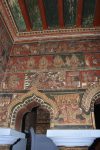
Date: mid-19th century
Description: Top row: Rishyashringa (Kalaikottu munivar) arrives in Ayodhya and is welcomed by Dasharatha Vasishtha and Sumantra; The putrakameshti yajna (ritual to obtain a son) is celebrated; Dasharatha divides the payasa among his three queens; Second row: The princes are trained in riding elephants, driving chariots and fencing; Third row: Vishvamitra tells Rama to kill the demoness Tataka and once she is dead, freed from her curse, her soul ascends to heaven; Vishvamitra, Lakshmana, Indra, other gods and the gandharvas praise Rama; Vishvamitra bestows the magical weapons on Rama; Fourth row: Four servants listen to Janaka’s command; Nine servants carry Shiva’s bow in the assembly hall.
Location: Tamil Nadu Palace;Bodinayakkanur
Positioning: Lakshmi Vilasam
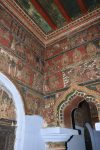
Date: mid-19th century
Description: Top row (from left to right): The wedding of Rishyashringa (Kalaikottu munivar) and Shanta; The sage travels in a palanquin to Ayodhya where he is welcomed by king Dasharatha and his courtiers; Second row: Vasishtha trains the princes in the martial arts; Third row: Vishvamitra tells Rama to kill Tataka; Fourth row: Janaka gives instructions to four servants.
Location: Tamil Nadu Palace;Bodinayakkanur
Positioning: Lakshmi Vilasam
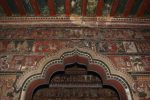
Date: mid-19th century
Description: Top row: Rishyashringa (Kalaikottu munivar), Vasishtha and other sages officiate at the putrakameshti yajna (ritual to obtain a son); The Yajnapurusha emerges from the flame carrying the bowl of payasa; Dasharatha divides the payasa among the queens; The pregnant queens and their attendants; Second row: The princes are trained in the martial arts; Third row: After killing Tataka Vishvamitra bestows upon Rama the magical weapons and teaches him how to use them; Fourth row: Janaka’s servants carry Shiva’s bow in the assembly hall.
Location: Tamil Nadu Palace;Bodinayakkanur
Positioning: Lakshmi Vilasam
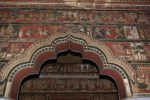
Date: mid-19th century
Description: Top row: Rishyashringa (Kalaikottu munivar), Vasishtha and other sages officiate at the putrakameshti yajna (ritual to obtain a son); The Yajnapurusha emerges from the flame carrying the bowl of payasa; Dasharatha divides the payasa among the queens; The pregnant queens and their attendants; Second row: The princes are trained in the martial arts; Third row: After killing Tataka Vishvamitra bestows upon Rama the magical weapons and teaches him how to use them; Fourth row: Janaka’s servants carry Shiva’s bow in the assembly hall.
Location: Tamil Nadu Palace;Bodinayakkanur
Positioning: Lakshmi Vilasam
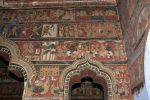
Date: mid-19th century
Description: Top row: The pregnant queens and their attendants; The queens give birth; Second row: The princes are trained in archery; Vasishtha tells king Dasharatha that their education is completed; Bharata and Shatrughna; Third row: Vishvamitra teaches Rama and Lakshmana how to use the magical weapons; They visit the hermitages of various ascetics and listen to their discourses; Fourth row: Seven servants carry Shiva’s bow; Two ushers.
Location: Tamil Nadu Palace;Bodinayakkanur
Positioning: Lakshmi Vilasam
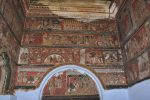
Date: mid-19th century
Description: Top row: The midwife informs the king that the queens have given birth and she is rewarded; King Dasharatha bestows gifts on the Brahmins; The four babies are given a bath; Second row; Rama aims mud pellets at Kuni (Manthara); The four princes and their mothers; An usher announces the arrival of Vishvamitra; Vasishtha, Dasharatha and Sumantra welcome him; Third row: The princes perform their ablutions and then proceed to guard the ascetics’ yajna from the onslaught of Subahu and Maricha; Subahu is killed, Maricha propelled by an arrow into the sea; Vishvamitra and the sages praise the princes; Rama and Lakshmana sleep under the watchful gaze of Vishvamitra; Fourth row: Shiva’s bow lies at Rama’s feet while he pays homage to Janaka and his entourage; Rama breaks the bow into three pieces before the assembled court and the princes invited to the svayamvara (bride’s own choice of a husband) are dismayed at being defeated.
Location: Tamil Nadu Palace;Bodinayakkanur
Positioning: Lakshmi Vilasam
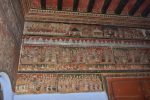
Date: mid-19th century
Description: Top row: Dasharatha’s party crosses the river, sets camp and is met by Janaka’s welcoming party; Second row: The wedding of the four Ikshvaku princes with the Mithila princesses; Third row: Rama and Sita, Lakshmana and Urmila are given a ceremonial bath.
Location: Tamil Nadu Palace;Bodinayakkanur
Positioning: Lakshmi Vilasam
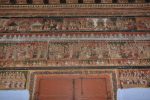
Date: mid-19th century
Description: Top row: The Mithila welcoming party escorts the guests on their way to the capital; Second row: The weddings of Bharata and Mandavi and of Shatrughna and Shrutakirti; The grooms garland the brides seated on their father’s thigh; Rama garlands Sita; Lakshmana garlands Urmila; Third row: Lakshmana and Urmila are given a ceremonial bath; At the centre: Door to the darbar hall.
Location: Tamil Nadu Palace;Bodinayakkanur
Positioning: Lakshmi Vilasam
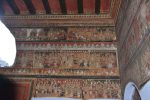
Date: mid-19th century
Description: Top row: Janaka and his entourage meet Dasharatha’s party; Second row: Lakshmana garlands Urmila; Shartughna garlands Shrutakirti and Bharata garlands Mandavi, the brides are seated on their father’s thigh; Third row: Bharata and Mandavi, Shartughna and Shrutakirti are given a ceremonial bath.
Location: Tamil Nadu Palace;Bodinayakkanur
Positioning: Lakshmi Vilasam
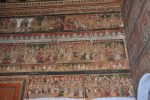
Date: mid-19th century
Description: Top row: Janaka and his entourage meet Dasharatha’s party; Second row: Lakshmana garlands Urmila; Shartughna garlands Shrutakirti and Bharata garlands Mandavi, the brides are seated on their fathers’ thigh; Third row: Bharata and Mandavi, Shartughna and Shrutakirti are given a ceremonial bath.
Location: Tamil Nadu Palace;Bodinayakkanur
Positioning: Lakshmi Vilasam
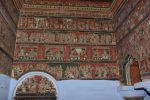
Date: mid-19th century
Description: Top row: At the gates of Mithila, Dasharatha embraces Janaka, Vasishtha embraces Janaka’s chaplain, Shatananda; The princes pay homage to Vasisthta. Once in town, the princes pay homage to Dasharatha while Vishvamitra looks on; Rama and Lakshmana pay homage to the three queens; Second row: As a part of the wedding ceremonial, the four couples look at the pole star; Third row: The couples in their apartments, the brides offer pan to their spouses; Fourth row: Janaka and Dasharatha accompanied by their entourage; The four Mithila princesses pay homage to Janaka and are given gifts.
In the arch above the door: Rama and his brothers pay homage to Dasharatha and the three queens.
Location: Tamil Nadu Palace;Bodinayakkanur
Positioning: Lakshmi Vilasam
1 2 3 … 11 Next »